2021 TOYOTA PROACE EV ECU
[x] Cancel search: ECUPage 119 of 360
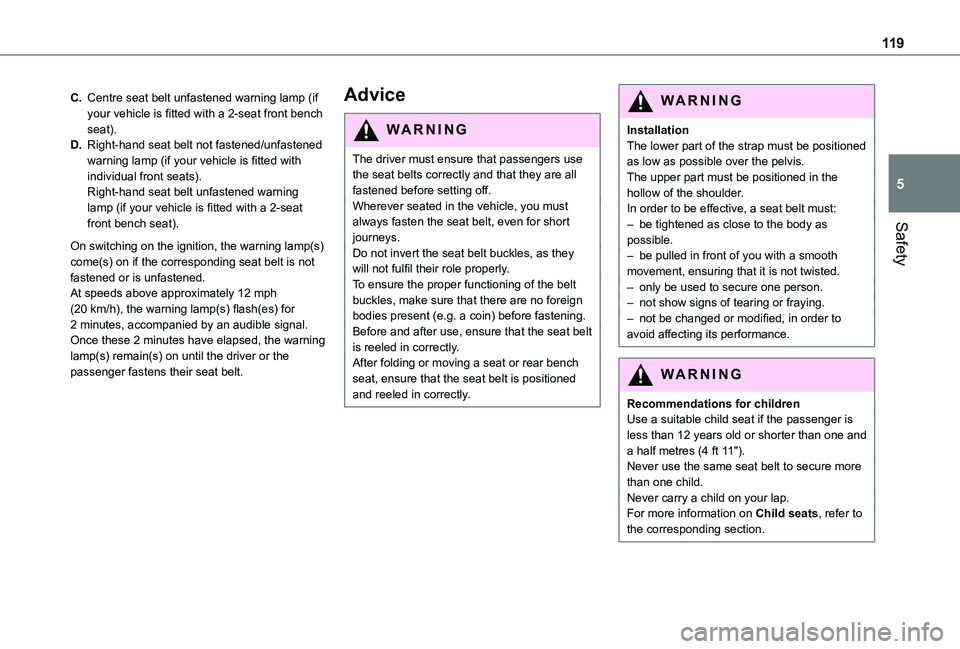
11 9
Safety
5
C.Centre seat belt unfastened warning lamp (if your vehicle is fitted with a 2-seat front bench seat).
D.Right-hand seat belt not fastened/unfastened warning lamp (if your vehicle is fitted with individual front seats).Right-hand seat belt unfastened warning lamp (if your vehicle is fitted with a 2-seat front bench seat).
On switching on the ignition, the warning lamp(s) come(s) on if the corresponding seat belt is not fastened or is unfastened.At speeds above approximately 12 mph (20 km/h), the warning lamp(s) flash(es) for 2 minutes, accompanied by an audible signal. Once these 2 minutes have elapsed, the warning lamp(s) remain(s) on until the driver or the passenger fastens their seat belt.
Advice
WARNI NG
The driver must ensure that passengers use the seat belts correctly and that they are all fastened before setting off.Wherever seated in the vehicle, you must always fasten the seat belt, even for short journeys.
Do not invert the seat belt buckles, as they will not fulfil their role properly.To ensure the proper functioning of the belt buckles, make sure that there are no foreign bodies present (e.g. a coin) before fastening.Before and after use, ensure that the seat belt is reeled in correctly.After folding or moving a seat or rear bench seat, ensure that the seat belt is positioned and reeled in correctly.
WARNI NG
InstallationThe lower part of the strap must be positioned as low as possible over the pelvis.The upper part must be positioned in the hollow of the shoulder.In order to be effective, a seat belt must:– be tightened as close to the body as possible.– be pulled in front of you with a smooth movement, ensuring that it is not twisted.– only be used to secure one person.– not show signs of tearing or fraying.– not be changed or modified, in order to avoid affecting its performance.
WARNI NG
Recommendations for childrenUse a suitable child seat if the passenger is less than 12 years old or shorter than one and a half metres (4 ft 11").Never use the same seat belt to secure more than one child.Never carry a child on your lap.For more information on Child seats, refer to the corresponding section.
Page 123 of 360

123
Safety
5
WARNI NG
Front airbagsDo not drive holding the steering wheel by its spokes or resting your hands on the centre part of the wheel.Passengers must not place their feet on the dashboard.Do not smoke as deployment of the airbags can cause burns or the risk of injury from a cigarette or pipe.Never remove or pierce the steering wheel or hit it violently.Do not fix or attach anything to the steering wheel or dashboard, as this could cause injuries when the airbags are deployed.
WARNI NG
Lateral airbagsUse only approved seat covers compatible with the deployment of these airbags. For information on the range of seat covers suitable for your vehicle, contact any authorized Toyota retailer or Toyota authorized repairer, or any reliable repairer.Do not fix or attach anything to the seat backrests (e.g. clothing) as this could cause injuries to the chest or arm when the airbag is deployed.Do not sit with the upper part of the body any nearer to the door than necessary.The vehicle's front door panels include side impact sensors.A damaged door or any unauthorised or incorrectly executed work (modification or repair) on the front doors or their interior trim could compromise the operation of these sensors - risk of malfunction of the lateral airbags!
All work must be carried out only by any authorized Toyota retailer or Toyota authorized repairer, or any reliable repairer.
PROACE VERSO
WARNI NG
Curtain airbagsDo not fix or attach anything to the roof, as this could cause head injuries when the curtain airbag is deployed.Do not remove the grab handles installed on the roof, as these help to secure the curtain airbags.
Page 124 of 360
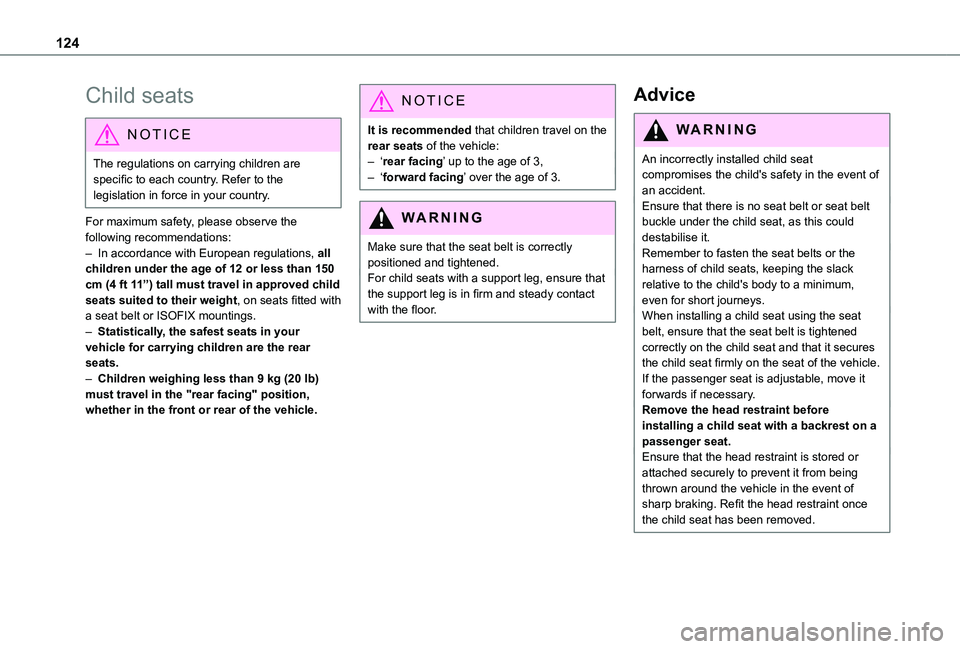
124
Child seats
NOTIC E
The regulations on carrying children are specific to each country. Refer to the legislation in force in your country.
For maximum safety, please observe the following recommendations:
– In accordance with European regulations, all children under the age of 12 or less than 150 cm (4 ft 11”) tall must travel in approved child seats suited to their weight, on seats fitted with a seat belt or ISOFIX mountings.– Statistically, the safest seats in your vehicle for carrying children are the rear seats.– Children weighing less than 9 kg (20 lb) must travel in the "rear facing" position, whether in the front or rear of the vehicle.
NOTIC E
It is recommended that children travel on the rear seats of the vehicle:– ‘rear facing’ up to the age of 3,– ‘forward facing’ over the age of 3.
WARNI NG
Make sure that the seat belt is correctly positioned and tightened.For child seats with a support leg, ensure that the support leg is in firm and steady contact with the floor.
Advice
WARNI NG
An incorrectly installed child seat compromises the child's safety in the event of an accident.Ensure that there is no seat belt or seat belt buckle under the child seat, as this could destabilise it.
Remember to fasten the seat belts or the harness of child seats, keeping the slack relative to the child's body to a minimum, even for short journeys.When installing a child seat using the seat belt, ensure that the seat belt is tightened correctly on the child seat and that it secures the child seat firmly on the seat of the vehicle. If the passenger seat is adjustable, move it forwards if necessary.Remove the head restraint before installing a child seat with a backrest on a passenger seat.Ensure that the head restraint is stored or attached securely to prevent it from being thrown around the vehicle in the event of sharp braking. Refit the head restraint once the child seat has been removed.
Page 127 of 360
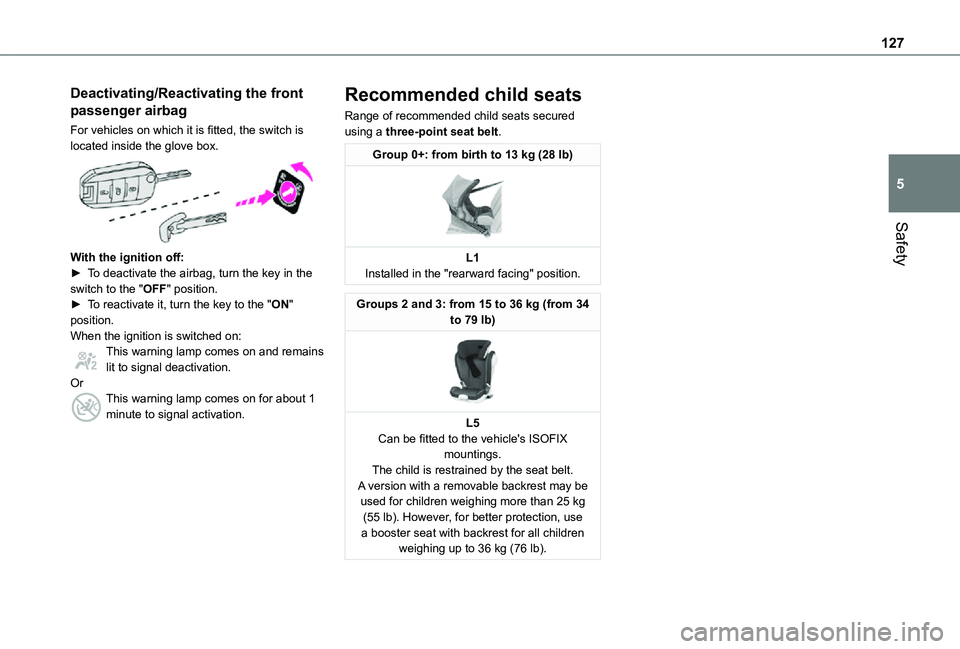
127
Safety
5
Deactivating/Reactivating the front
passenger airbag
For vehicles on which it is fitted, the switch is located inside the glove box.
With the ignition off:► To deactivate the airbag, turn the key in the switch to the "OFF" position. ► To reactivate it, turn the key to the "ON" position.When the ignition is switched on:This warning lamp comes on and remains lit to signal deactivation.OrThis warning lamp comes on for about 1 minute to signal activation.
Recommended child seats
Range of recommended child seats secured using a three-point seat belt.
Group 0+: from birth to 13 kg (28 lb)
L1Installed in the "rearward facing" position.
Groups 2 and 3: from 15 to 36 kg (from 34 to 79 lb)
L5Can be fitted to the vehicle's ISOFIX
mountings.The child is restrained by the seat belt.A version with a removable backrest may be used for children weighing more than 25 kg (55 lb). However, for better protection, use a booster seat with backrest for all children weighing up to 36 kg (76 lb).
Page 128 of 360
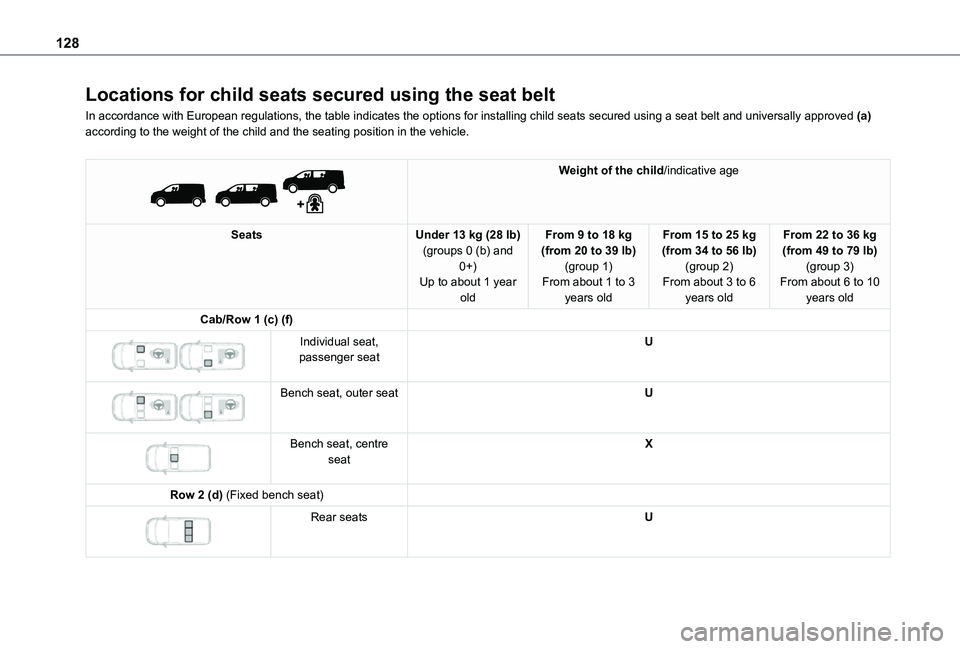
128
Locations for child seats secured using the seat belt
In accordance with European regulations, the table indicates the options\
for installing child seats secured using a seat belt and universally ap\
proved (a) according to the weight of the child and the seating position in the veh\
icle.
Weight of the child/indicative age
SeatsUnder 13 kg (28 lb)(groups 0 (b) and 0+)Up to about 1 year old
From 9 to 18 kg (from 20 to 39 lb)(group 1)From about 1 to 3 years old
From 15 to 25 kg (from 34 to 56 lb)(group 2)From about 3 to 6 years old
From 22 to 36 kg (from 49 to 79 lb)(group 3)From about 6 to 10 years old
Cab/Row 1 (c) (f)
Individual seat, passenger seatU
Bench seat, outer seatU
Bench seat, centre seatX
Row 2 (d) (Fixed bench seat)
Rear seatsU
Page 131 of 360
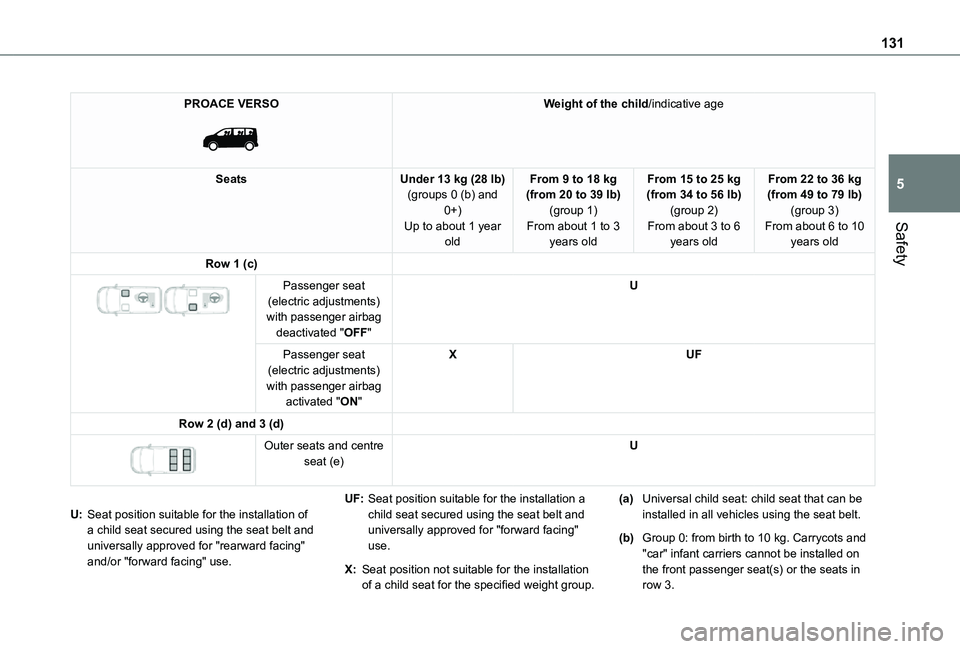
131
Safety
5
PROACE VERSO
Weight of the child/indicative age
SeatsUnder 13 kg (28 lb)(groups 0 (b) and 0+)Up to about 1 year old
From 9 to 18 kg (from 20 to 39 lb)(group 1)From about 1 to 3 years old
From 15 to 25 kg (from 34 to 56 lb)(group 2)From about 3 to 6 years old
From 22 to 36 kg (from 49 to 79 lb)(group 3)From about 6 to 10 years old
Row 1 (c)
Passenger seat (electric adjustments) with passenger airbag deactivated "OFF"
U
Passenger seat (electric adjustments) with passenger airbag activated "ON"
XUF
Row 2 (d) and 3 (d)
Outer seats and centre seat (e)U
U:Seat position suitable for the installation of a child seat secured using the seat belt and
universally approved for "rearward facing" and/or "forward facing" use.
UF:Seat position suitable for the installation a child seat secured using the seat belt and universally approved for "forward facing"
use.
X:Seat position not suitable for the installation of a child seat for the specified weight group.
(a)Universal child seat: child seat that can be installed in all vehicles using the seat belt.
(b)Group 0: from birth to 10 kg. Carrycots and "car" infant carriers cannot be installed on the front passenger seat(s) or the seats in row 3.
Page 132 of 360
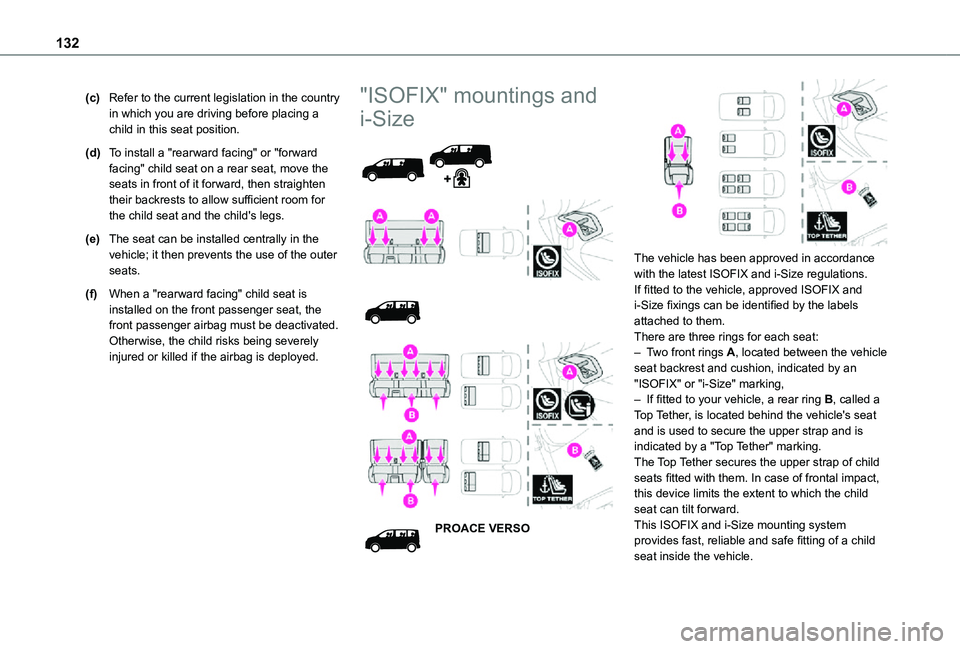
132
(c)Refer to the current legislation in the country in which you are driving before placing a child in this seat position.
(d)To install a "rearward facing" or "forward facing" child seat on a rear seat, move the seats in front of it forward, then straighten their backrests to allow sufficient room for the child seat and the child's legs.
(e)The seat can be installed centrally in the vehicle; it then prevents the use of the outer seats.
(f)When a "rearward facing" child seat is installed on the front passenger seat, the front passenger airbag must be deactivated. Otherwise, the child risks being severely injured or killed if the airbag is deployed.
"ISOFIX" mountings and
i-Size
PROACE VERSO
The vehicle has been approved in accordance with the latest ISOFIX and i-Size regulations.If fitted to the vehicle, approved ISOFIX and i-Size fixings can be identified by the labels attached to them.There are three rings for each seat:– Two front rings A, located between the vehicle seat backrest and cushion, indicated by an "ISOFIX" or "i-Size" marking,– If fitted to your vehicle, a rear ring B, called a Top Tether, is located behind the vehicle's seat and is used to secure the upper strap and is indicated by a "Top Tether" marking.The Top Tether secures the upper strap of child seats fitted with them. In case of frontal impact, this device limits the extent to which the child seat can tilt forward.This ISOFIX and i-Size mounting system provides fast, reliable and safe fitting of a child
seat inside the vehicle.
Page 133 of 360
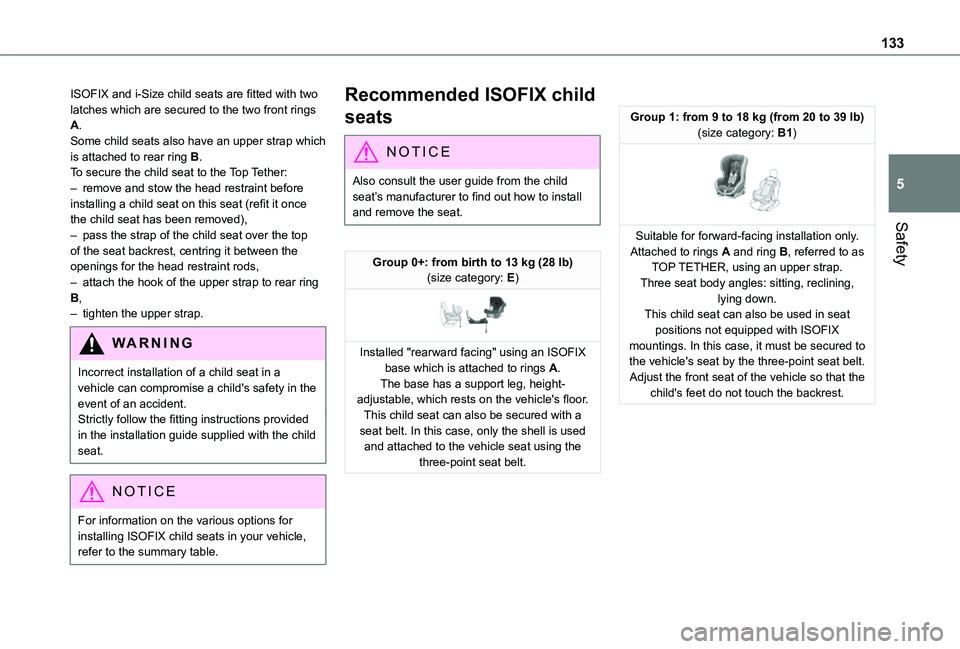
133
Safety
5
ISOFIX and i-Size child seats are fitted with two latches which are secured to the two front rings A.Some child seats also have an upper strap which is attached to rear ring B.To secure the child seat to the Top Tether:– remove and stow the head restraint before installing a child seat on this seat (refit it once the child seat has been removed),– pass the strap of the child seat over the top of the seat backrest, centring it between the openings for the head restraint rods,– attach the hook of the upper strap to rear ring B,– tighten the upper strap.
WARNI NG
Incorrect installation of a child seat in a vehicle can compromise a child's safety in the event of an accident.Strictly follow the fitting instructions provided in the installation guide supplied with the child seat.
NOTIC E
For information on the various options for installing ISOFIX child seats in your vehicle,
refer to the summary table.
Recommended ISOFIX child
seats
NOTIC E
Also consult the user guide from the child seat’s manufacturer to find out how to install and remove the seat.
Group 0+: from birth to 13 kg (28 lb)(size category: E)
Installed "rearward facing" using an ISOFIX base which is attached to rings A.The base has a support leg, height-adjustable, which rests on the vehicle's floor.This child seat can also be secured with a seat belt. In this case, only the shell is used and attached to the vehicle seat using the three-point seat belt.
Group 1: from 9 to 18 kg (from 20 to 39 lb)(size category: B1)
Suitable for forward-facing installation only.Attached to rings A and ring B, referred to as TOP TETHER, using an upper strap.Three seat body angles: sitting, reclining, lying down.This child seat can also be used in seat positions not equipped with ISOFIX mountings. In this case, it must be secured to the vehicle's seat by the three-point seat belt. Adjust the front seat of the vehicle so that the child's feet do not touch the backrest.